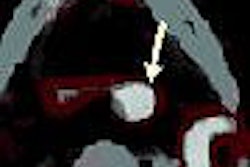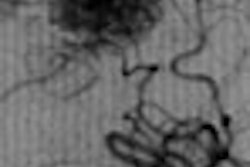In one of the first head-to-head comparisons of radiation dose between dual- and single-source CT, a multi-institutional research team has concluded that for a given noise level, images can be obtained at comparable or lower doses using dual-source CT versus single-source 64-slice CT.
Dual-source CT improves ECG-gated cardiac imaging results because its high temporal resolution is available across the full range of heart rates, added lead author Cynthia McCollough, Ph.D., and her colleagues in the U.S. and Germany.
Of course, the new-generation 64-slice CT scanners are themselves a vast improvement over earlier four- and 16-slice technology, yielding improved spatial resolution (0.4-mm isotropic voxels with advanced z-sampling techniques), as well as better temporal resolution in cardiac imaging due to gantry rotation times as low as 0.33 sec, the researchers noted in Radiology.
"However, these decreases in gantry rotation time necessitated decreases in pitch to avoid gaps in the volume coverage at lower heart rates, and the reduction in pitch led to an increase in the radiation dose for 64-channel systems relative to 16-channel systems," they wrote (Radiology, published online before print, April 19, 2007).
Beta-blockade to slow the heart rate is one solution to coverage gaps, but improving temporal resolution to 100 msec is a better way. Achieving high resolution on 64-slice CT requires either multisegment reconstruction, which is feasible for only very steady heartbeats, or single-segment reconstruction combined with ultrafast gantry rotation times of 0.2 sec or less, which are beyond the technical capabilities of today's scanners, the researchers wrote.
Another solution is the dual-source CT scanner (Siemens Medical Solutions, Malvern, PA), which is equipped with two x-ray tubes and two corresponding detectors.
McCollough and her colleagues from the Mayo Clinic College of Medicine in Rochester, MN, along with Thomas Flohr, Ph.D., from the University of Tübingen in Tübingen, Germany, and researchers from Siemens Medical Solutions (who did not control the data), sought to prospectively compare the dose performance of single-source 64-slice CT (Sensation 64) with that of a dual-source scanner (Somatom Definition), both from Siemens Medical Solutions.
In cardiac (or dual-source) mode, the scanner employs several dose-reduction features, including a cardiac beam-shaping filter that attenuates the x-ray beam before it reaches the patient to eliminate unnecessary peripheral radiation. The shaping feature can restrict the dose to the area of the anatomy being imaged, the authors explained.
The 3D adaptive noise-reduction feature works by calculating linear variances for several directions in the 3D image space to determine the orientation of edges, and "the minimum variance is assumed to be oriented tangentially to the contour with the highest contrast," the authors wrote.
"Depending on the local distribution of variances, intermediate data are mixed by the algorithm by using local weighting factors to obtain the final reconstructed image; the optimal adapted filter is the combination that maximizes the noise reduction with negligible deterioration of signal intensity," McCollough and colleagues wrote.
The heart rate-dependent pitch feature synchronizes the patient's heart rate with the gantry rotation time. Both 64-slice and dual-source CT have a gantry rotation time of 0.33 sec, but they are used quite differently. While single-source CT reaches 83-msec temporal resolution using dual-segment reconstruction at 66, 81, and 104 beats per minute (bpm), dual-source offers 83-msec resolution at all heart rates by using data from only one cardiac cycle, the authors stated. The table feed and corresponding pitch can also be adapted to the heart rate.
The fourth feature, electrocardiographic modulation of the tube current throughout the cardiac cycle, has been shown to reduce the dose by as much as 50%, the authors wrote.
To assess the degree of dose reduction from each dose-reduction feature, the researchers calculated the weighted CT dose index (CTDIw) per 100 mAs for the head, body, and cardiac beam-shaping filters. They measured the kerma-length product in the spiral cardiac mode at four pitch values and in three ECG modulation temporal windows. Anthropomorphic phantoms were used to measure noise, and all of the results were compared for 64-slice and dual-source CT.
The results for CTDIw per 100 mAs for both single- and dual-source CT are listed below:
|
In cardiac mode (i.e., no electrographically based tube modulation, 0.2 pitch), "equivalent noise occurred at volume CT dose index values of 23.7 and 35.0 mGy (coronary artery calcium CT), and 58.9 and 61.2 mGy (coronary CT angiography) for multidetector-row CT and dual-source CT, respectively," the authors wrote.
The use of heart-rate-adjusted pitch cut volume CT dose index values to 46.2 mGy (0.265 pitch), 34 mGy (0.36 pitch), and 26.6 mGy (0.46 pitch) compared with 61.2 mGy for a pitch of 0.2, they noted. Finally, ECG-based tube current modulation and temporal windows of 110, 210, and 310 msec further reduced volume CT dose index to a range of 9.1-25.1 mGy, depending on the heart rate, the group reported.
"The data presented here demonstrate that the simultaneous operation of two x-ray sources need not contribute to an increase in the dose for electrocardiographically gated cardiac CT examinations; rather, the doses from (ECG-gated coronary CTA) can be reduced by up to a factor of two relative to single-source multidetector-row CT, depending on the heart rate of the patient," the authors reported.
Although dual-source CT did produce an 88% increase in dose compared to single-source when both x-ray sources were in operation, the increase was more than compensated for by the use of the four dose-reduction methods, they noted.
"The capability to raise pitch to values as high as 0.5 for heart rates of more than 100 beats per minute is a direct consequence of the 83-msec temporal resolution of the dual-source CT system that requires only single-segment reconstructions at all heart rates," McCollough and her colleagues wrote.
ECG-based tube current modulation can reduce dose 30% to 50% for single-source CT, but few sites use it routinely for their cardiac CTA exams because the optimal reconstruction phase can vary by several hundred milliseconds between end systole and end diastole, and "if the optimal phase occurs at a point at which the tube current has been decreased, the image quality will not be sufficient," they stated. With dual-source CT, however, the 83-msec temporal resolution shows negligible motion artifact in the coronary arteries at all heart rates, the authors wrote.
With dual-source, technical mechanisms can be used to reduce the dose for cardiac CT applications without diminution of the image quality, although clinical evaluations will be needed to determine the applicability of the technology in a broad range of patients, the authors stated.
Limitations of the study include reliance on a single 64-slice CT scanner, they wrote, although this choice limited potential sources of variation because both scanners have identical data-acquisition systems. In addition, assumptions about the appropriate temporal window in dual-source CT to balance competing needs for robustness and dose reduction will need to be validated in further studies. A second assumption, that a temporal resolution of 83 msec will be adequate for all heart rates, is also unproven.
"If further improvements in temporal resolution are found to be clinically necessary for higher and varying heart rates, multisector reconstruction approaches might also be needed for dual-source CT," they wrote.
"At present, researchers in two preliminary studies conclude that (dual-source CT) technology offers robust image quality independent of heart rate," the authors noted.
By Eric Barnes
AuntMinnie.com staff writer
April 26, 2007
Related Reading
Dual-source coronary CTA images the calcium-burdened, March 13, 2007
64-slice cardiac CT points to important incidental findings, March 29, 2007
Radiation dose slashed in 64-slice coronary CTA, February 15, 2007
Dual-energy CT may assist in coronary plaque identification, January 15, 2007
Copyright © 2007 AuntMinnie.com




















